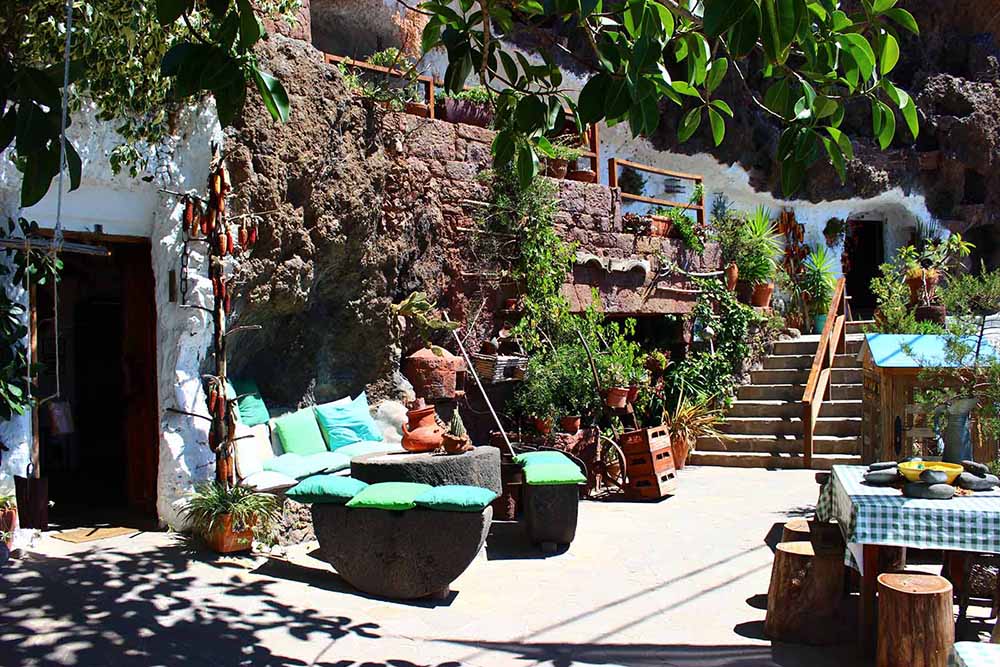ARTENARA
Oficina de Información Turística
Martes a sábado de 11.30 h. a 16.30 h.
+34 638 959 509
+34 928 666 102

Artenara
El pueblo de las Casas Cueva
Artenara
El pueblo de las Casas Cueva
ARTENARA
Oficina de Información Turística
Martes a sábado de 11.30 h. a 16.30 h.
+34 638 959 509
+34 928 666 102

Artenara
El pueblo de las Casas Cueva
Artenara
El pueblo de las Casas Cueva
ARTENARA
In Cave no. 7, we have tried to recreate what is most representative of a traditional Artenara kitchen.
At the entrance there are usually 4 large stones, a fire was made between them, and the cooking was done on this fire. There are some of the original cooking pots displayed here.
Before entering the cave on our left, is a traditional oven used to bake bread.
This was carried out fortnightly for the entire community, and made in the basin that is located inside on the left of the kitchen. The excess bread is baked again to turn it into “bread bisque” and thus increase its conservation. To find firewood in those times was a costly exercise, in terms of time, because of its rarity. Near the door we find the fire box, made with red stone of Tirma and located on the outside of the cave, to prevent smoke inside.
There were no chimneys in the caves.
On the work surface of the kitchen to the right, you can see how to make gofio (the staple food of the local population). Traditionally the items that were used by the original Canarian people to make gofio were dried beans, wheat, oats, rye and barley. After the Spanish conquest of America, with the importation of maize, this changed the customs and sweet corn is now the favourite item for the present day Canarian gofio.
There are two earthenware roasters on the right, one was for the unroasted natural corn and in the other toasted corn. The stone mill was used to grind the roasted corn to make the rich and aromatic gofio.
This is a large high altitude area, where sheep and goats have plenty of grazing, it is a very good area for cheese production. The cheese in this area has been traditionally made from the milk of both goats and sheep, as it still is today. There are two forms of fermenting the milk (a) a ferment with animal rennet, and (b) using plants with fermenting properties such as the stamens of the flower of the thistle, or artichoke.
The waste water from the cheese, the whey, was mixed with gofio to make a basic food for these families, since the milk or cheese were considered valuable objects for sale and not for their own consumption.
Among the animals that were bred and raised were black pigs, twice a year some animals were slaughtered. A few days before Christmas a killing was carried out (on the table “tocinera”) the meat divided equally among all the families nearby, out of a sense of community and also recognizing that all helped a little by bringing the scraps of food daily to feed the pigs. The meat of the pig was supposed to last up to Shrove Tuesday and should not be eaten later than that. The next pig is killed just before summer and the meat was preserved to last up to Christmas. The meat was preserved in a large earthenware jar “Tanaja de Lozo” the meat was mixed with olive oil that came from Temisas or Santa Lucia de Tirajana or in its own fat or lard. Meat was also preserved in brine in stone carved basins, from Arucas, using salt that was obtained from the salt flats near Agaete or Galdar.
Various old kitchen utensils are displayed in this cave.